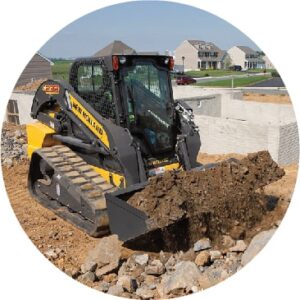Compact Track Loaders: Which Undercarriage is Best?
Secure footing and traction are crucial for safe, productive operation of compact track loaders (CTLs). The smarter you are about choosing the undercarriage configuration, the more confident you can be in your loader’s performance and profitability. While the undercarriage represents about 20% of the CTL’s initial cost, it represents more like 50% of its ongoing maintenance expense.
You’ve made the decision to choose tracks over tires. But not all track systems are the same, and what’s different about them can affect the CTL’s performance quality, efficiency and overall durability, not to mention operator comfort. So it pays to investigate the details before choosing an undercarriage design that will give you the best tool for your types of jobs.
 Rigid Mount vs Suspended Mount
Rigid Mount vs Suspended Mount
The undercarriage on a compact track loader can be rigid, fully suspended, or a hybrid design.
With rigid mounting, the undercarriage and mainframe move as one. A suspended undercarriage can move independently of the mainframe, which the distance between the right and left carriage and the loader lift arms to fluctuate. That can be a good thing, or not, depending on the work to be done.
Since the rigid configuration is stiff and uniformly controllable (something like a dozer), it generally works better for grading or leveling. With a suspension system, the inherent variability can make it hard to “fine tune” the surface. On the other hand, suspended mounting typically functions better in situations that call for two-speed travel, higher speed travel, and/or transporting materials longer distances.
The Rigid Option
This is the simpler undercarriage option. Rigid mount compact track loader usually cost less than those with suspended undercarriages. And with fewer moving parts, there is less to maintain or wear out.
However, while stiff suspension is a plus for race car drivers, it is not much fun for CTL operators on a construction site. Every bump and motion is jarring, making for an uncomfortable, tiring work day. Some OEMs offer suspended seats to help soften the impact, but there’s another problem. All that jarring can jostle material out of the bucket, and it’s tough on components, leading to premature (and costly) wear.
Manufacturers often add high-strength leaf springs attached to bogie wheels, which help absorb impact as the machine works.
 The Suspended Option
The Suspended Option
With an undercarriage built much like the suspension system in a passenger car, this CTL provides a far more operator-friendly ride — over uneven terrain and while loading and lifting. It conforms better to surfaces, making it more stable and easier to control even at high speeds. Some manufacturers offer both “multi-terrain” compact track loader with heavy-duty torsion axles on each side and rubber track and rubber-coated roller wheels. The result is a machine that can work in more difficult terrain with optimal flotation and operator comfort.
Instead, compact track loaders with suspended undercarriages may feature all-steel components with steel-embedded rubber track, a configuration that can be more versatile and cost-effective to operate.
Single-level suspension is the basic style, using independent torsion axles connected to the chassis along with bogie wheels to reduce vibration and shock impact. In a dual-level suspension, the bogie wheels can flex with the track and the torsion axles are mounted between the undercarriage and chassis.
There’s One More Thing to Consider
Choosing the most beneficial type of undercarriage is crucial if you hope to get the most from your compact track loader. But what about the enclosure? Should it be open or closed?
A metal enclosure protects the track tensioner, wheel and sprocket mountings from debris such as dirt, sticks, and rocks. But it’s not fully sealed, so any debris that gets inside tends to stay there, increasing wear on the components. An open design enables debris to get in but also fall out, so it is essentially self-cleaning. This can extend component life by as much as 50%. For service techs, open design allows easier access for maintenance and parts replacement, too.
Rigid or suspended. Open or closed. The decisions you make about undercarriage design for your compact track loader will affect its performance, durability, and operator comfort.
